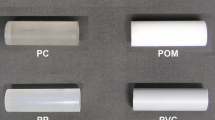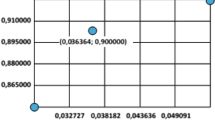Summary
Paralleling the development of strain hardening for the pressure-independent von Mises criterion, a simple plasticity model in strain space was presented to characterize strain hardening for pressure-sensitive compressible materials. Two hardening moduli,H T andH C , which emerged from the constitutive equations and can becalculated from uniaxial stress-strain curves in tension and compression, were used to characterize the strainhardening responses forgeneral and special stress systems. The results indicated the implications and restrictions of the yield function on the hardening responses. It was also shown that strain softening, under general stress systems, can be a natural consequence of pressure-sensitive yielding. Consequently, a strain-space formulation is recommended for most (if not all) pressure-sensitive plasticity models. Preliminary application to the yielding of polymers under hydrostatic pressure gave reasonable results for polyethylene at moderate pressure and small strains; the results for polycarbonate were generally poor. Finally, the advantages and limitations of the present approach were discussed.
Similar content being viewed by others
References
Kiousis, P. D.: Strain space approach for softening plasticity. J. Eng. Mech.113, 210–221 (1987).
Spitzig, W. A., Richmond, O.: Effect of hydrostatic pressure on the deformation behavior of polyethylene and polycarbonate in tension and in compression. Poly. Eng. Sci.19, 1129–1139 (1979).
Spitzig, W. A., Sober, R. J., Richmond, O.: The effect of hydrostatic pressure on the deformation behavior of maraging and HY-80 steels and its implications for plasticity theory. Metall. Trans. A.7 A, 1703–1710 (1976).
Drucker, D. C.: Plasticity theory, strength-differential (SD) phenomenon, and volume expansion in metals and plastics. Metall. Trans.4, 667–673 (1973).
Casey, J., Lin, H. H.: Strain-hardening topography of elastic-plastic materials. J. Appl. Mech.50, 795–801 (1983).
Naghdi, P. M., Trapp, J. A.: The significance of formulating plasticity theory with reference to loading surfaces in strain space. Int. J. Eng. Sci.13, 785–797 (1975).
Casey, J., Naghdi, P. M.: On the characterization of strain-hardening plasticity. J. Appl. Mech.48, 285–296 (1981).
Valanis, K. C.: On the uniqueness of solution of the initial value problem in softening materials. J. Appl. Mech.52, 649–653 (1987).
Lee, J. H.: Research note on a simple model for pressure-sensitive strain-hardening materials. Int. J. Plasticity4, 265–278 (1988).
Raghava, R. S., Caddell, R. M.: A macroscopic yield criterion for crystalline polymers. Int. J. Mech. Sci.15, 967–974 (1973).
Casey, J., Sullivan, T. D.: Pressure dependency, strength-differential effect, and plastic volume expansion in metals. Int. J. Plasticity1, 39–61 (1985).
Dorris, J. F., Nemat-Nasser, S.: A plasticity model for flow of granular materials under triaxial stress states. Int. J. Solids Structures18, 497–531 (1982).
Christiansen, A. W., Baer, E., Radcliffe, S. V.: The mechanical behavior of polymers under high pressure. Phil. Mag.24, 451–467 (1971).
Casey, J., Jahedmotlagh, H.: The strength-differential effect in plasticity. Int. J. Solids Structures.20, 377–393 (1984).
Tschoegel, N. W.: Failure surfaces in principal stress space. J. Polymer Sci. Sym.32, 239–267 (1971).
Doraivelu, S. M., Gegel, H. L., Gunasekera, J. S., Malas, J. C., Morgan, J. T., Thomas, J. F.: A new yield function for compressible P/M materials. Int. J. Mech. Sci.9/10, 527–535 (1984).
Nemat-Nasser, S., Shokooh, A.: On finite plastic flows of compressible materials with internal friction. Int. J. Solids Structures16, 495–514 (1980).
Chandler, H. W.: A plasticity theory without Drucker's postulate, suitable for granular materials. J. Mech. Phys. Solids.33, 215–226 (1985).
Cristescu, N.: Plasticity of compressible/dilatant rocklike materials. Int. J. Engng. Sci.10, 1091–1100 (1985).
Author information
Authors and Affiliations
Additional information
With 6 Figures
Rights and permissions
About this article
Cite this article
Lee, J.H. Characterization of strain hardening for a simple pressure-sensitive plasticity model. Acta Mechanica 77, 133–151 (1989). https://doi.org/10.1007/BF01178318
Received:
Revised:
Issue Date:
DOI: https://doi.org/10.1007/BF01178318




